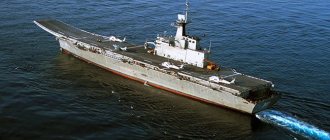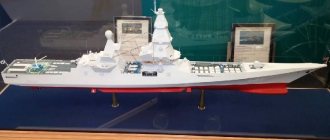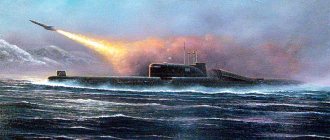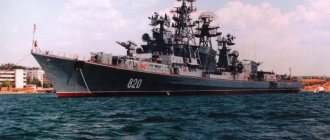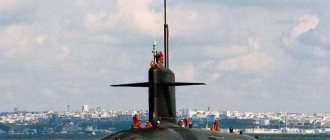Project 1234 code "Gadfly" small missile ships
In terms of architecture, the smooth-deck hull of the ship, Project 1234, has boat-like contours, a slight sheerness, a longitudinal framing system and is made of high-strength ship steel MK-35. The hull has a double bottom along most of its length and is divided by nine bulkheads into 10 watertight compartments. Bulkheads are located on frames 11, 19, 25, 33, 41, 46, 57, 68 and 80, on frames 87. — transom. The lower part of the bulkheads is made of steel grade 10 KHSN 2D (SHL-45), and the upper part is made of aluminum-magnesium alloy grade AMg61. Only the bulkheads on frames 11, 46 and the transom are made entirely of steel grades 10 KHSN D or 10 KHSN 2D (SHL-45).
Read more…
Admiral Graf Spee - German battleship of World War II
According to the Treaty of Versailles, concluded after the First World War in 1919, severe restrictions were imposed on Germany, including everything related to its ability to have large warships. It was allowed to build ships with a displacement of no more than 10,000 tons, armed with guns of no more than 11 inch caliber. (280 mm). The Allies hoped, through such bans, to limit the scope of use of German warships only to the Baltic Sea and thus guarantee themselves against a threat from Germany in the future. At the end of the twenties, the Germans had completely different plans.
Read more…
"Bora" and "Samum" - small hovercraft missile boats
There are no analogues in the world to these unique small hovercraft missile boats “Bora” and “Samum” of Project 1239 “Sivuch”. The sailors themselves call them “Sea Destroyer.” When attacking the enemy, suddenly approaching at enormous speed, which is twice the speed of any surface ship, he destroys the flagship of the enemy squadron with missiles brought into combat position in just thirty seconds, leaving it without command. And he leaves there at the same speed, allowing him, after delivering a blow, to instantly leave the zone of destruction of the enemy’s fire forces.
Read more…
Interception in the Arctic
In September 2022, the Russian fleet stopped an attempt by NATO ships to stage a provocation in the Arctic waters of the Russian Federation.
Then the warships of Germany and Norway were heading to the Northern Sea Route. However, having begun to advance to the indicated point, the ships of the block encountered significantly superior forces of the Russian navy, bomber and fighter aircraft. Moscow's preventive actions did not allow NATO to carry out a provocation in the Arctic zone. As the Russian Ministry of Defense later noted, the actions of the fleet demonstrated that Russia is ready to act extremely harshly towards its opponents who want to violate territorial borders.
Project 11540 “Yastreb” (Nonstrashimy type) – patrol ships (frigates)
One of the few ships introduced into the Russian Navy in the last decade is the patrol ship Neustrashimy, built at a shipbuilding plant in Kaliningrad according to project 11540 Yastreb. The development of the project was started by the design bureau in Zelenograd in 1981; the Project 1135 patrol ship “Burevestnik” was used as a prototype. Patrol ships of this type are designed to carry out convoy operations and patrol duty, search, track and combat enemy surface ships and submarines, and repel attacks by enemy air attacks. Technical capabilities allow ships of this type to remain at sea for a long time and control significant air and water space.
Read more…
Incident near the Crimean Peninsula
The British destroyer Defender entered the Black Sea on June 14, 2022. He arrived in the port of Odessa to participate in the NATO military exercises Sea Breeze, which were planned from June 28 to July 10. However, on June 23, a ship of Her Majesty's naval forces, moving along a route in neutral waters, abruptly changed course and headed towards the Crimean Peninsula.
According to official representatives of the Russian Ministry of Defense, the British destroyer, which was in full combat readiness, crossed the Russian border and entered the country's territorial waters in the area of Cape Fiolent at 11:52. The ship's crew did not respond to the warning from the Russian border services. At 12:06, the Russian patrol ship fired a warning salvo, followed by another two minutes later.
After Russian border guards made an unsuccessful attempt to contact the captain of the British ship, Su-24Ms flew into the detection area and carried out warning bombing. The shells were dropped along the course of the destroyer. 10 minutes later, the British ship left Russian territorial waters. As representatives of the Russian defense department later emphasized, the actions of the Defender crew were a gross violation of the UN Convention on the Law of the Sea. During the annual direct line, which took place on June 30, Russian President Vladimir Putin said that the situation with the British destroyer was a complex provocation organized not only by the British, but also by the Americans.
Japanese Ise-class battleships of World War II
American air attack on the battleship Ise
When launched from the stocks in 1914, the Fuso and its sister ship, the Yamashiro, completed in 1915, were the most powerful battleships of the Japanese Navy. In 1916 and 1917 To the first two, two more ships of the same class were added, Ise and Hyuga. In terms of firepower, they were superior to most large ships of the US Navy and were approximately equal to the Pennsylvania-class battleships. The appearance of warships of this class in Japan meant a loud statement of the country about itself as a major maritime power. 14-in. (356-mm) Fuso main caliber guns were manufactured in Japan; the layout of the gun turrets was atypical: two were installed in front, two in the rear, and two more in the middle of the ship.
Read more…
Exercises in the Sea of Japan
In the same year, but later, another resonant episode occurred with the participation of the American fleet. On October 15, the US Navy destroyer Chafee (DDG 90) approached Russian territorial waters and attempted to cross the state border in the Sea of Japan. It is noteworthy that before the incident, the American vessel operated in this water area for several days.
After a US Navy guided-missile destroyer failed to respond to repeated warnings from Russian border guards, the large anti-submarine ship Admiral Tributz was sent to intercept it. An attempt by the crew of the BOD to prevent the further advancement of Chafee almost turned into a real combat collision: the crew of the American destroyer tried to ram the Admiral Tributz, and only a few seconds before the collision it broke apart side to side at a distance of just over 50 meters.
The destroyer URO "Chafee", convinced of the determination of the crew of the Russian ship to prevent violation of the state border, changed direction and at 17:50 turned back on the opposite course, when there were less than 60 meters left to the BOD "Admiral Tributs", the Russian Ministry of Defense commented on the incident in the Gulf of Petra Great. Representatives of the department regarded this as a gross violation of international rules.
"Albion" - landing helicopter dock ship of the British Navy
The British Navy landing ships Fairless and Intrepid, laid down in 1962, were to be decommissioned in 1981, according to the Conservative government's plans, depriving the Royal Marines of mobility. This policy largely influenced Argentina's decision to land on the Falkland Islands in 1982. The decommissioning of the ships was delayed and they played a decisive role in the liberation of the islands. The decision to replace them was made 10 years later, but two new Albion-class landing ships were laid down only in 1998 and 2000, when the Intrepid was already dismantled.
Read more…
Provocation in Peter the Great Gulf
On November 24, 2022, the American destroyer John McCain entered Russian territorial waters two kilometers into the Sea of Japan. The large anti-submarine ship of the Pacific Fleet, Admiral Vinogradov, was sent to intercept the armed ship of the US Navy.
The Russian ship approached the American one, and the crew of the Admiral Vinogradov warned the captain of the destroyer John McCain about violating the borders and called on him to immediately leave the territorial waters of the Russian Federation. And although the US Navy destroyer stopped moving, it absolutely did not want to leave Russian waters. However, after a warning shot was fired from the Admiral Vinogradov, the American ship immediately entered neutral waters.
Later, the command of the US Seventh Fleet explained the John McCain maneuver as an operation “to ensure freedom of navigation.”
Project 1135 "Burevestnik" (Bditelny type) - patrol ships
Project 1135, codenamed “Burevestnik”, was developed by the Northern Design Bureau from 1964 to 1966. and provided for the creation of a large anti-submarine ship, the main armament of which was to be the 84-R missile-torpedoes of the Metel complex (URPK-4). A special feature of the ship was the presence, along with the Titan-2 hydroacoustic station located in the nose cone, of a station with a towed Vega antenna. Moreover, due to the relatively short range of hydroacoustic stations, the ships of this project were planned to be used in pairs: one search, the other attack.
Read more…
"Moscow"
"Moskva", guards missile cruiser. Multipurpose ship. Built at the shipyards of the plant named after 61 Communards in Nikolaev. Initially it was called “Slava”. Commissioned in 1983. The flagship of the Russian Black Sea Fleet. Participated in the military conflict with Georgia, in 2014 he carried out a blockade of the Ukrainian Navy. With a width of 20.8 meters, it has a length of 186.4 meters and a displacement of 11,490 tons. Maximum speed 32 knots. Cruising range up to 6000 nautical miles. A crew of 510 people can stay in “autonomy” for a month. Armament: 16 P-500 “Basalt” mounts, two AK-130 artillery mounts, six 6-barreled AK-630 artillery mounts, B-204 S-300F “Reef” air defense systems (64 missiles), “Osa-MA” air defense system launchers (48 missiles), torpedo tubes, RBU-6000 rocket launchers, Ka-27 helicopter. A copy of the Moscow, the cruiser Varyag is the flagship of the Pacific Fleet.

